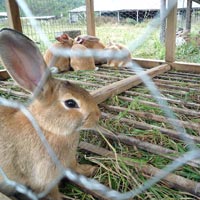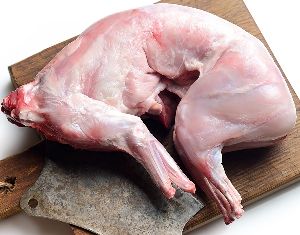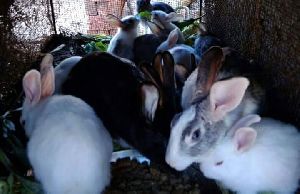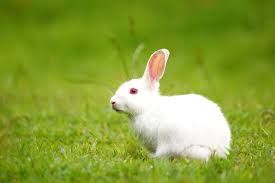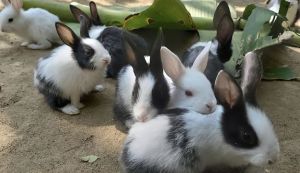Listing ID #1299603
Company Information
Ask for more detail from the seller
Contact SupplierWe are engaged in providing complete guidance to farmers who are willing to start Rabbit Farming. Rabbit Farming has become very popular, owing to its higher returns and less risk involved. Our diligent team members are engaged in offering in-depth knowledge regarding Rabbit Farming, which includes breeding, caring, maintaining, treatment, etc.
History
The existence of rabbit with human being remained from the time immemorial. Romans were the first to domesticate wild rabbits. Wild rabbit Oryctolagus cuniculus of southern Europe and North Africa is thought to have been discovered by Phoenicians when they reached the shores of Spain about 1000 BC. In Roman times the rabbit was still emblematic of Spain. The Romans apparently spread the rabbit throughout the Roman Empire as a game animal. Like the Spaniards of that time, they ate fetuses or newborn rabbits, which they called laurices.
Several breeds of rabbit were known in the 16th century and this is the first record we have of controlled breeding. Domestication can therefore be traced to the date middle Ages. This was probably the work mainly of monks, since it provided them with a more delectable dish than the tougher wild rabbit.
In the 16th century breeding seems to have spread across France, Italy, Flanders and England. In 1595, Agricola mentions the existence of gray brown (wild), white, black, piebald (black and white) and ash grey rabbits. In 1606, Olivier de Serres classified 3 types of rabbit: the wild rabbit, the semi wild or "warren" rabbit raised inside walls or ditches, and the domesticated or hutch-bred rabbit. The meat of the last is described as insipid, and that of the wild or semi wild type as delicate.
Introduction
The Food and Agriculture Organization's (FAO) strategy to fight world hunger has rabbit as its key component. . Increased awareness of the high potential of meat rabbit production has made a positive impact on the lives of the majority of subsistence, limited-resource rural and per urban populations in Western countries. In developing countries such as India, where enormous meat shortages exist, the potential for rabbit production is greatest Rabbit meat serves a source of Low saturated fat for the population overfed countries and as a source of cheap animal protein in underfed countries, thus exhibiting the varied potential of rabbit farming. Broiler rabbits must be considered as an important contributor of protein source to assure food security because of the ability of the species to produce high quality and quantity of meat. China is the largest producer of rabbit meat, constituting approximately 40% of global production.
Global Rabbit Meat Production
Most of the remainder of global production occurs in Europe. Other Asian countries viz. Thailand and Vietnam are also in the producers list.
China accounts for approximately a quarter of world exports, with The Netherlands, Germany, Japan, Switzerland, the United States and other European countries being the major importing nations. Current rabbit meat supply is far below estimates of domestic and export demand. The world production of rabbit meat is valued to be about 1 million tons; of this the 54% is produced in the EU. The four biggest world�s producers � China, Italy, Spain, and France � contribute to almost ¾ of the world production.
The international trade of rabbit meat involves almost 50 thousands tons, equal to almost the 5% of the world production, to confirm that the principal part of the world�s production is destined to the domestic use80 % of the world imports are made by the European Union. Main importer countries: Italy, Belgium, France, Germany. Main exporter countries: China, Eastern Europe countries. Organized promotion of rabbit production in India took place
Broiler Rabbit farming in India
During the late seventies by the import of rabbits from the UK and the former USSR, by the Central Sheep and Wool Research Institute of the Indian Council of Agricultural Research. In India, rabbit rearing has attracted farmers since the last ten to 12 years. The ever growing demand for non vegetarian proteins in developing countries like India helps the rabbit industry to grow further and further. Though it has not made an impact in the meat industry in India, there is tremendous scope for popularizing rabbit meat. In India, the production of rabbit meat had not reached any marked stage. The breeds mainly reared in India are crosses of New Zealand White, Soviet chinchilla and Dutch crosses.
Rabbit Housing
The ideal direction for rabbit shed in East West. Temperature inversion factor plays important role in rabbit farming. Hence appropriate provisions for temperature maintenance should be made to avoid stress on animals. In the modern production systems of livestock, rabbit rearing is still kept under traditional pattern i.e. Deep litter. This system is mainly followed in some of the Asian countries viz. Vietnam , Bangkok which are engaged in extensive rabbit farming with a population of at least 25000 heads in one housing.
The cage system of rearing replaced floor system in the late 1990�s. The cages are erected on wooden poles, steel bars and on stones. Bucks and Does are housed separately in individual compartments.


